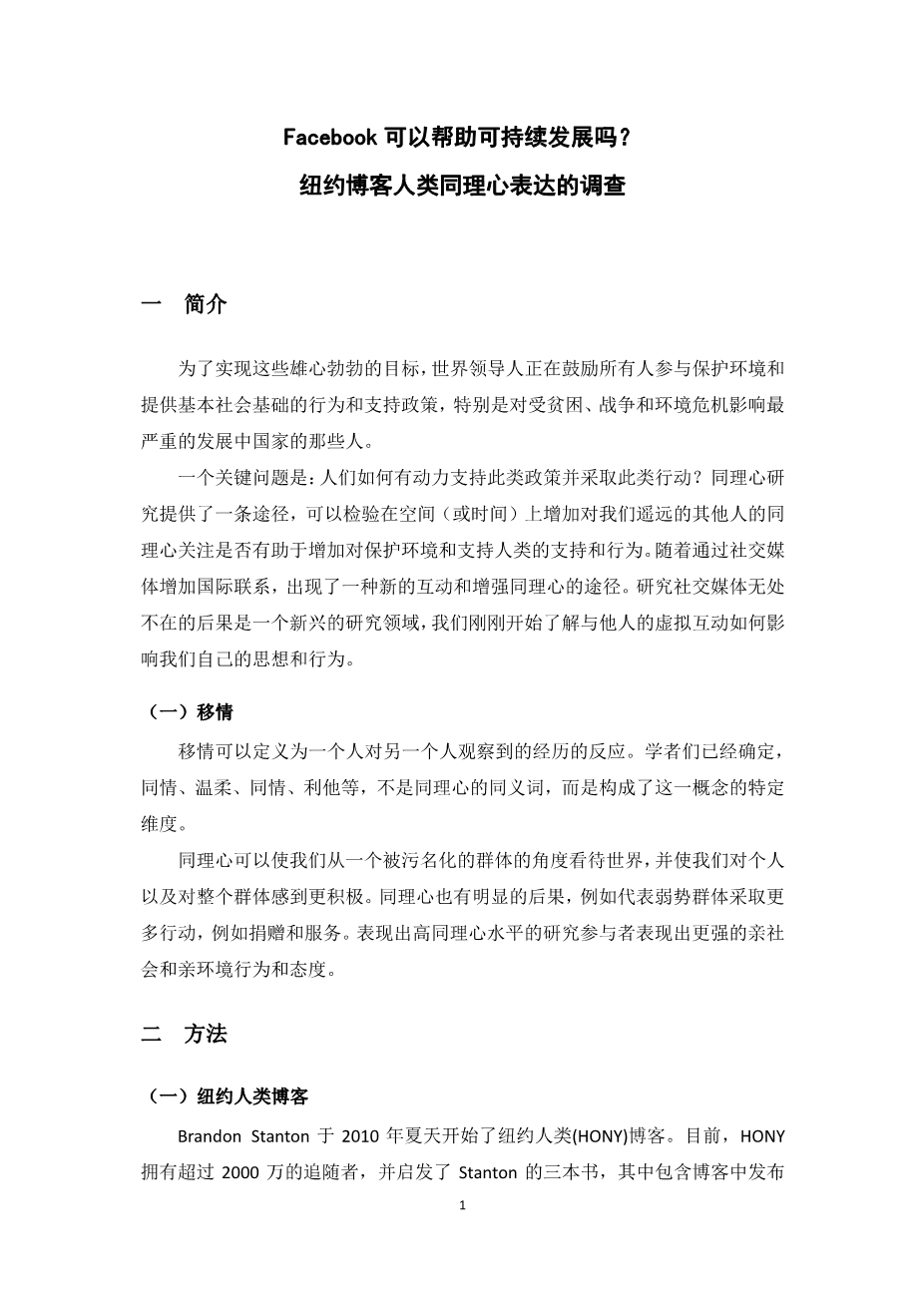Can Facebook Aid Sustainability?
An Investigation of Empathy Expression within the
Humans of New York Blog
1. Introduction
To reach these ambitious goals, world leaders are encouraging all people to engage in behaviors and support policies that protect the environment and provide basic social foundations, especially tothose in developing countries most affected by poverty, war, and environmental crisis.
One key question is: How are people motivated to support such policies and undertake such actions? Research on empathy offers a pathway to examine whether increasing empathetic concern for others distant to us in space (or time) can aid in increasing support for, and behaviors to, protect the environment and support humanity. With international connectivity increasing via social media, a new avenue for interaction and increasing empathy has emerged. Studying the consequences of the ubiquitous nature of social media is a newly emerging field of research where we are just beginning to understand how virtual interaction with others impacts our own thoughts and behaviors.
1.1. Empathy
Empathy can be defined as the reactions of one individual to the observed experiences of another. Scholars have determined that sympathy, tenderness, compassion, altruism, etc., are not synonymous with empathy, but constitute specific dimensions of the concept.
Empathy can cause us to see the world from the perspective of a stigmatized group and make us feel more positively towards individuals as well as toward the whole group. There are also visible consequences of empathy, such as increased action on behalf of a disadvantaged group such as donations and servic. Study participants who show a high empathy level display stronger pro-social and pro-environmental behaviors and attitudes.
2. Methods
2.1. Humans of New York Blog
Brandon Stanton began the Humans of New York (HONY) blog in the summer of 2010. Currently, HONY has over 20 million followers, and has inspired three books by Stanton which feature photos and stories posted from the blog. We began with the hypothesis that HONY provides a platform for virtual parasocial intergroup contact and is therefore a valuable study mechanism for expressions of virtual empathy, especially given its immense global reach.
2.2. Procedure
The process used in this study can best be described as a collective case study. We used purposeful sampling to identify posts from each of the two time frames. For the Vidal case study, we chose interactions between Stanton, Vidal, and the principal of Vidalrsquo;s school, Mrs. Lopez. In addition, we chose posts that captured the main storyline along with results, which included pictures with Vidalrsquo;s family and their eventual meeting with President Barack Obama.
Next, the full text of each (1) original post, (2) comments from blog followers, and (3) responses/discussion about comments by blog followers, were fully categorized to identify the portions of the postrsquo;s dataset pertinent to this research. We began our collective case study analysis guided by the work of Davis to create an a priori coding scale based on the Interpersonal Reactivity Index (IRI) used to measure individualrsquo;s empathy.
3. Results and Discussion
3.1. Perspective Taking
People commented that before following the HONY blog, they were unable to take the perspective of another because they were unaware of the lives of others around the globe. These people were formally so disengaged with global issues that they failed to recognize the everyday lives, and specifically the plights, of others.
Comments show that the HONY blog allowed people to see the lsquo;humannessrsquo; of others living peaceful, everyday lives, that are from regions where most media reporting shows chaos and violence. “These posts show you the real Middle East. Kids playing in the street, lovingfamilies, hard workers and a generous welcoming culture. But also the real strugglestheyface. Unemployment, poverty, war crimes.
3.2. Empathic Concern
Many individuals realized how fortunate they were by comparing their own lives to those of the photo subjects. One photo showed a broken hearted man who was unable to marry the woman he loved due to his own social standing. A commenter remarked, “Take a second to appreciate the privilege of being able to love someone of your own choosing.” Others stated that they were thankful they did not have to worry about some of the problems that the photo subjects had, and that they felt sympathetic toward them.Many expressions of EC utilized the words suffer and struggle. Primarily, these words were used to acknowledge that others were going through difficult times, and the commenters were able to empathize with that.
3.3. Personal Distress
Instances of PD were characterized by emotional reactions and physical responses. Emotional reactions included declarations such as, “this is so heartbreaking” and “probably one of the saddest things I have ever read.” Commenters were sometimes angry and frustrated, “This makes me ANGRY!” and “Irsquo;m enraged . . . ” The final emotional expression of PD was concern or worry, exemplified by comments such as, “I was worry about these kids”.
Physical responses included people feeling sick after reading the stories or looking at photos: “[This] makes me sick . . . ” People reported feeling pain as a type of empathic response. For example, one commenter said, “It actually pains me physically when . . . ” Finally, a common response was people saying they were so sad or distraught after looking at the blog that they were crying. Examples include, “Yoursquo;re making me cry,” or, “I have welled eyes and chills”.
4. Conclusions
The HONY blog p
剩余内容已隐藏,支付完成后下载完整资料


英语译文共 3 页,剩余内容已隐藏,支付完成后下载完整资料
资料编号:[589911],资料为PDF文档或Word文档,PDF文档可免费转换为Word


